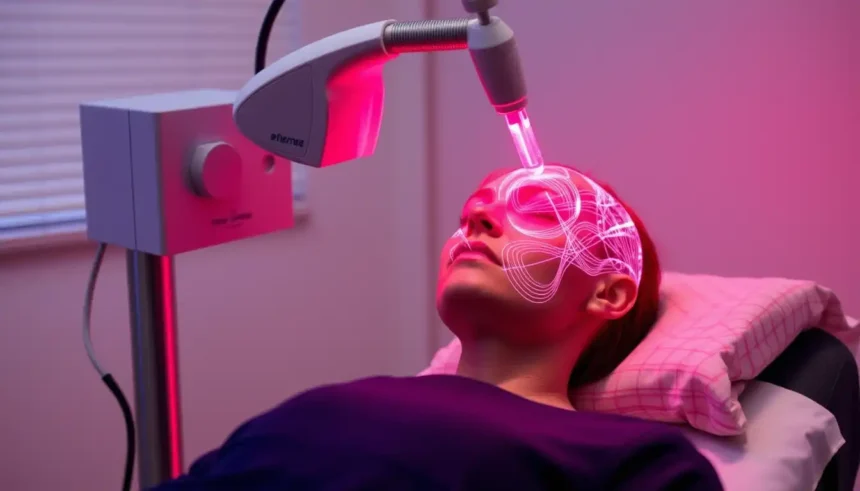Have you ever wondered how science is pushing the boundaries of mental health treatment? Transcranial Magnetic Stimulation (TMS) is one such innovation that has been making waves in the field. Imagine a therapy that can influence brain activity without surgery or medication. TMS uses magnetic fields to target specific brain areas, offering new hope for those struggling with conditions like depression and OCD. Since its inception in 1985, TMS has evolved into a widely accepted treatment, even earning approval from the FDA. Whether you’re curious about how it works or consider it a treatment option, this article will guide you through everything you need to know about TMS.
Understanding Transcranial Magnetic Stimulation (TMS)
Since we started Healthworks Collective, our goal has been to explore treatments that might ease the burden of mental illness in practical and honest ways. You may have heard of Transcranial Magnetic Stimulation (TMS), a therapy that uses magnetic pulses to influence brain activity without medication. It is one of the approaches that has gained attention as more people seek help for conditions that don’t respond well to standard treatments. There are millions of individuals who haven’t found relief through traditional means, and this therapy offers another route.
There are 57.8 million people in the United States living with some form of mental illness, according to the National Alliance on Mental Illness. You can imagine how overwhelming it is for people trying to find something that works when the first few treatments fail. It is in these difficult cases that TMS therapy is often introduced. Keep reading to learn more.
How TMS Works and Who It Helps
TMS involves placing a magnetic coil against the scalp to stimulate specific parts of the brain associated with mood regulation. There are few side effects, and it does not require anesthesia or sedation. You might find this helpful if medication has not worked well or caused unwanted complications. It is also a non-invasive approach, making it more appealing to people wary of other options.
You might be wondering how effective this therapy really is. A 10-year study shared by Science Direct looked at a clinic treating people with psychiatric disorders that resisted other forms of care. There are three outcome categories they recorded: 26.1% of patients responded, 29.2% had a partial response, and 44.7% saw little to no effect. It is still a developing option, and these numbers show that while TMS doesn’t work for everyone, it does help a significant portion.
There are several mental health conditions where TMS has been explored as a potential treatment. Access Community Health Network reports that anxiety disorders, major depression, and bipolar disorder are the most common diagnoses. You are not alone if you’re struggling with any of these, and you may find value in speaking with a provider who knows about newer therapies. It is difficult to navigate mental health treatment, especially when the process of finding the right one can take years.
You deserve more than trial and error when it comes to your mental health. It is frustrating to try different combinations of therapy and medication, only to come up short. There are options like TMS that some have found helpful, and discussing them with a healthcare provider might make a difference. You should feel like you’re moving forward, even if it takes small steps.
According to experts at PTC PSYCHIATRY TREATMENT CENTERS®, Transcranial Magnetic Stimulation (TMS) is a groundbreaking therapy that offers a non-invasive approach to influencing brain activity. By utilizing strong magnetic fields, TMS targets specific areas of the brain associated with mood regulation and decision-making. This technique has gained attention for its ability to treat various mental health conditions without the need for surgery or medication. TMS has evolved significantly since its development in 1985, becoming a widely accepted treatment option. The U.S. Food and Drug Administration (FDA) has approved TMS for treating major depression and obsessive-compulsive disorder (OCD), highlighting its effectiveness and safety.
The journey of TMS from its inception to FDA approval underscores its potential in mental health treatment. Initially developed by researchers in England, TMS has undergone extensive research and refinement. Its non-invasive nature means that patients can undergo treatment without anesthesia, making it a more accessible option for many individuals. The procedure involves placing a magnetic coil on the scalp, which generates pulses that stimulate nerve cells in targeted brain regions. This stimulation can lead to significant improvements in symptoms for those who have not responded well to traditional treatments like medication or psychotherapy.
How Does TMS Work?
Transcranial Magnetic Stimulation (TMS) operates on the fascinating principles of electricity and magnetism. At its core, TMS uses magnetic fields to influence the brain’s natural electrical activity. This is possible because the neurons in our brain communicate through electrical signals. By applying a magnetic field, TMS can modulate these signals, effectively targeting specific areas of the brain associated with emotions and decision-making. This targeted approach allows for precise intervention in mental health conditions like depression and OCD.
The effectiveness of TMS largely depends on the type of magnetic coils used during treatment. Several coils are designed to reach different depths and areas within the brain. For instance, repetitive transcranial magnetic stimulation (rTMS) typically uses a figure-eight coil focusing on surface-level brain regions. In contrast, deep transcranial magnetic stimulation (dTMS) employs an H-coil capable of penetrating deeper into the brain’s structures. These coils generate magnetic pulses that can vary in frequency and pattern:
- Low-frequency pulses: Generally used to calm overactive areas of the brain.
- High-frequency pulses: Often employed to stimulate underactive regions.
This flexibility in coil design and pulse modulation makes TMS a versatile tool for addressing various mental health challenges, offering hope where traditional treatments may have failed.
Types of TMS Treatments
Transcranial Magnetic Stimulation (TMS) therapy offers various treatment options, each tailored to address specific mental health conditions. Two primary forms of TMS are repetitive transcranial magnetic stimulation (rTMS) and deep transcranial magnetic stimulation (dTMS). Both methods utilize magnetic fields to influence brain activity but differ in their approach and application. rTMS involves using a small, sealed device placed on the scalp that generates a magnetic field through a coil. This method is known for its repetitive pulses that target areas of the brain associated with mood regulation. On the other hand, dTMS employs an H-shaped coil that can penetrate deeper into the brain, reaching regions about 4 centimeters beneath the skull’s surface. This makes dTMS particularly effective for conditions like depression and obsessive-compulsive disorder (OCD).
The differences between rTMS and dTMS extend beyond just coil types; they also involve variations in pulse frequency and patterns. For instance, rTMS typically uses high-frequency pulses ranging from 5 Hz to 10 Hz. At the same time, dTMS may employ different pulse patterns, such as theta-burst stimulation (TBS), which delivers rapid bursts of pulses. These distinctions are crucial as they determine the suitability of each treatment for specific conditions. Here’s a quick overview of which conditions each type is best suited for:
- rTMS: Often recommended for individuals with treatment-resistant depression or those who have not responded well to antidepressant medications.
- dTMS: Approved by the FDA for treating both depression and OCD, offering a deeper reach into brain structures.
By understanding these differences, patients and healthcare providers can decide which TMS treatment is most beneficial based on individual needs and medical history.
Conditions Treated by TMS
Transcranial Magnetic Stimulation (TMS) therapy has emerged as a promising treatment for various mental health conditions. Among the most common disorders treated with TMS are depression, obsessive-compulsive disorder (OCD), and post-traumatic stress disorder (PTSD). These conditions often resist traditional treatments, making TMS a valuable alternative. By targeting specific areas of the brain associated with mood regulation and emotional processing, TMS offers hope to individuals who have not found relief through medication or psychotherapy. The non-invasive nature of TMS, combined with its ability to influence brain activity precisely, makes it an attractive option for those seeking effective treatment.
In addition to its established uses, ongoing research explores new applications for TMS therapy. Scientists are investigating its potential benefits for conditions such as bipolar disorder, anxiety, and even chronic pain. This expanding field of study highlights the versatility of TMS in addressing a wide range of neurological and psychiatric issues. As research progresses, we may see TMS becoming a standard treatment option for a broader spectrum of conditions. For now, it remains a beacon of hope for those struggling with treatment-resistant mental health disorders.
The TMS Procedure: What to Expect
When preparing for a Transcranial Magnetic Stimulation (TMS) session, there are several steps to ensure the process goes smoothly. Before the session begins, patients are advised to remove any magnetic-sensitive items, such as jewelry or credit cards. This precaution helps prevent interference with the magnetic fields used during treatment. Additionally, healthcare providers often supply earplugs to protect against the loud clicking sounds generated by the TMS machine. Patients should also arrange transportation after their initial sessions, as some individuals might experience mild headaches or discomfort, making driving uncomfortable.
Patients sit comfortably in a specially designed chair during a TMS session. The healthcare professional will position a magnetic coil on the patient’s scalp, targeting specific brain areas associated with mood regulation and decision-making. As the treatment begins, patients may feel a tapping sensation on their head, which is generally well-tolerated. Sessions typically last between 20 and 40 minutes, depending on the protocol. Patients might experience brief sensations such as tingling or lightheadedness throughout this time. It’s essential to communicate any discomfort to the attending technician, who can make necessary adjustments to enhance comfort and effectiveness.
Benefits of Transcranial Magnetic Stimulation
Transcranial Magnetic Stimulation (TMS) offers several compelling benefits over traditional treatments like Electroconvulsive Therapy (ECT) or medication, particularly for individuals grappling with severe depression. One of the most significant advantages of TMS is its non-invasive nature. Unlike ECT, which requires anesthesia and induces seizures to achieve therapeutic effects, TMS uses magnetic fields to stimulate specific areas of the brain without the need for surgical intervention or sedation. Patients can undergo treatment sessions without the recovery time associated with more invasive procedures.
Moreover, TMS boasts a favorable safety profile, making it an attractive option for those who have not found relief through medication. While medications can lead to a range of side effects, TMS is generally well-tolerated with minimal adverse reactions. Common side effects, such as headaches or slight discomfort during treatment sessions, are usually mild and temporary. Importantly, TMS has shown promising effectiveness rates, offering hope to those with treatment-resistant depression. Studies indicate that many patients experience significant symptom relief and, in some cases, complete remission. The potential life-saving benefits of TMS cannot be overstated, as it provides an alternative path to recovery for individuals who might otherwise face limited options.
- Non-invasive procedure: No surgery or anesthesia required.
- Minimal side effects: Generally mild and temporary discomfort.
- High effectiveness rates: Significant improvement in symptoms for many patients.
- Life-saving potential: Offers hope for those with severe, treatment-resistant depression.
Potential Side Effects and Risks
When considering Transcranial Magnetic Stimulation (TMS) therapy, knowing the potential side effects and risks associated with the treatment is essential. While TMS is generally well-tolerated, some individuals may experience mild side effects. The most common include headaches, which typically subside shortly after a session, and discomfort or tingling sensations at the site where the magnetic coil is placed. These sensations are usually temporary and diminish as the body adjusts to the treatment. Patients might also notice brief episodes of lightheadedness or muscle twitching. Still, these are generally not severe enough to disrupt daily activities.
Despite its non-invasive nature, TMS does carry rare but serious risks that should not be overlooked. One such risk is the possibility of experiencing a seizure, although this occurs in less than 0.01% of cases. It’s crucial for anyone considering TMS to consult with a healthcare provider to evaluate their health profile and determine if TMS is a suitable option. Certain conditions, such as having metal implants or a history of seizures, may preclude someone from undergoing this therapy. Discussing your medical history and any concerns with a professional can ensure that TMS is safe and effective for your specific needs.
Who Should Consider TMS Therapy?
Transcranial Magnetic Stimulation (TMS) therapy is particularly beneficial for individuals who have not found relief through traditional treatments. Suppose you or someone you know is struggling with treatment-resistant depression or Obsessive-Compulsive Disorder (OCD). In that case, TMS might be a viable option. This non-invasive procedure offers hope to those who have unsuccessfully tried multiple medications and therapies. TMS can significantly improve symptoms where other methods have failed by targeting specific areas of the brain associated with mood regulation and decision-making.
However, it’s essential to consider specific contraindications before opting for TMS therapy. Individuals with metal implants, such as cochlear implants or metal plates in the skull, should avoid this treatment due to the powerful magnetic fields involved. Additionally, those with a history of seizures or epilepsy need to exercise caution, as TMS can potentially trigger seizures in rare cases. It’s crucial to consult with a healthcare provider to assess your medical history and determine if TMS is a suitable and safe option for you. By understanding the benefits and limitations of TMS, you can make an informed decision about whether this innovative therapy could be the right path toward improved mental health.
Summary
Transcranial Magnetic Stimulation (TMS) is an innovative therapy that has revolutionized how we approach mental health treatment. Using magnetic fields to target specific brain areas, TMS offers a non-invasive alternative to traditional methods like medication and surgery. Since its inception in 1985, TMS has gained widespread acceptance, particularly after receiving FDA approval for treating major depression and OCD. This therapy’s ability to modulate brain activity without anesthesia makes it accessible and appealing to many patients who have not found relief through conventional treatments.
The effectiveness of TMS lies in its precision and adaptability. Different types of coils and pulse patterns allow for targeted intervention in various mental health conditions. For instance, repetitive transcranial magnetic stimulation (rTMS) focuses on surface-level brain regions. In contrast, deep transcranial magnetic stimulation (dTMS) reaches deeper structures. This flexibility enables TMS to address a range of disorders, from depression and OCD to PTSD and beyond. As research continues, the potential applications for TMS expand, offering hope to those with treatment-resistant conditions and paving the way for more personalized mental health care solutions.









